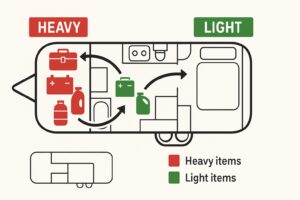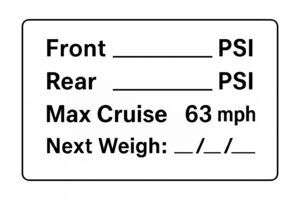The Four-Corner Weigh-In
How accurate RV weights + smarter speed save fuel, tires, and repair bills
Why “close enough” weight guesses cost you money
Most owners air up the tires to a round number, set the cruise to 68–72 mph, and hope for the best. The RV four-corner weigh tells you the real load on each wheel. That lets you set PSI from the manufacturer’s RV tire load chart, even out-of-side-to-side cargo, and then derate your cruising speed to the sweet spot where heat, rolling resistance, and fuel burn all drop. The result: tangible fuel savings, cooler tires, smoother handling, and far fewer roadside dramas.
What you can save:
- Fuel: Typically 6–12% by pairing correct PSI with a 5–8 mph speed reduction.
- Tires & damage avoidance: A single prevented blowout can avoid $300–$1,000+ in rubber, wheel well damage, wiring, trim, and downtime.
- Brakes, bearings, and suspension: Cooler, happier components last longer (soft savings, real money).
Step-by-step: The Four-Corner Weigh-In Method
 Weigh all four corners (or both duals on each axle).
Weigh all four corners (or both duals on each axle).- Best: Mobile RV rallies/shops with individual scale pads.
- Backup: A three-pass CAT scale (left/right bias estimated). If you must estimate, add a 10% safety margin to the heavier side.
- Find the tire manufacturer’s load/pressure chart for your exact size and load range.
- Match the heaviest corner on that axle to the minimum PSI that supports it.
- Add a small operational buffer (often +5 PSI) for temp swings and gauge variance—but never exceed wheel or valve-stem ratings.
 Rebalance your cargo.
Rebalance your cargo.- Move tools, water, batteries, and bulky gear toward the lighter side.
- Even 40–80 lb shifted across the aisle can reduce scrub, sway, and shoulder wear.
- Derate your highway speed.
- Lock in a cruise around 60–63 mph (or the speed where your engine runs lowest BSFC in top gear).
- Heat drops, rolling resistance falls, and your tires live a longer, quieter life.

 Record and re-check.
Record and re-check.- Make a windshield card: “Front: __ PSI | Rear: __ PSI | Max Cruise: 63 mph | Next Weigh Date: __”
- Re-weigh after big changes (full water, new tools, bikes, solar batteries, etc.).
Quick math: what 6–12% fuel savings looks like
- Trip: 5,000 miles
- Current: 9 mpg, fuel $3.75/gal → 556 gallons = $2,085
- After weigh-in + speed derate: 9.6–10.1 mpg → 490–521 gallons = $1,838–$1,955
- Savings: $130–$247 this trip alone, plus tire life and fewer emergencies.
Pro details most people miss
- Motorhome PSI is axle-specific. You can (and often should) run different pressures front vs. rear. Trailers are Tire Size Specific.
- Duals care about match. If you run duals, keep tire circumference and PSI closely matched to avoid overloading one side.
- Temperature matters. Check cold PSI at roughly the same morning temp; expect ~1–2 PSI change per 10°F.
- Valve stems & wheels have ratings. Don’t push PSI beyond the wheel or stem spec—upgrade if needed.
- TPMS is a tool, not a plan. It warns you after things heat up. Correct corner weights prevent the heat in the first place.
Common mistakes (and easy fixes)
- Guessing PSI from a forum post → Fix: Always use the exact RV tire load chart for your tire brand/size/load range.
- Inflating to sidewall max as a cure-all → Fix: Sidewall max is a limit, not a goal. Aim for chart-derived PSI + small buffer.
- Trailer tires should always be at Max Tire Pressure.
- Ignoring side-to-side bias → Fix: Move heavy items toward the light side; re-weigh.
- Driving 70+ to “make time” → Fix: A steady 62–63 often arrives within minutes of a faster run once you add fuel and stop time—and it saves cash.
The 20-minute driveway routine (between official weigh-ins)
- Air to your last chart-based PSI.
- Use a quality digital gauge; verify with a second gauge quarterly.
- Do a slow walk-around: tread/shoulders even? caps tight? valve stems intact?
- Check torque on lugs per schedule.
- Confirm your Max Cruise reminder on the dash.
Safety and legality
- Never exceed GAWR (Gross Axle Weight Rating) or GVWR.
- If the four-corner weigh pushes you close to limits, shed cargo or consider higher-capacity tires/wheels only within axle and wheel ratings.
- For propane, avoid prolonged high-heat runs; speed derating helps keep that front bay cooler, too.
Conclusion for The Smart RVer
“Today’s Money Saving Tip is the Four-Corner Weigh-In. Weigh each wheel, set PSI from your tire’s load chart, rebalance that cargo, and then cap your cruise around sixty-two. Most RVers see 6–12% better fuel economy, cooler tires, and far fewer blowouts. We’ll help you pick the right gauge, TPMS, and valve stems so your next trip is safer and cheaper.”
I can’t find a four-corner scale. Is axle weighing still useful?
Yes. Do a three-pass CAT scale (left tires off the pads, then right) to estimate side bias. Add ~10% margin to the heavier side when setting PSI until you can get true corner weights.
Is higher PSI always safer?
Not always. Over-inflation for your actual load reduces the contact patch and can increase stopping distance and center wear. Use the RV tire load chart for your tire, then add a small buffer.
How slow should I go?
Many rigs see the best balance of time vs. money around 60–63 mph. If traffic is 75+, stay in the right lane with professional spacing. Safety first.
Do I change PSI for hot afternoons?
No—set cold PSI in the morning. Tires are designed to gain pressure as they warm. Chasing hot PSI numbers leads to under-inflation.
Will this improve handling?
Yes. Balanced loads + correct PSI reduce wander, sway, and braking drama. Your suspension will thank you.
